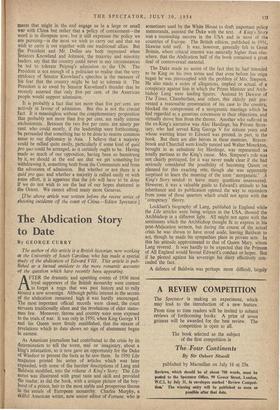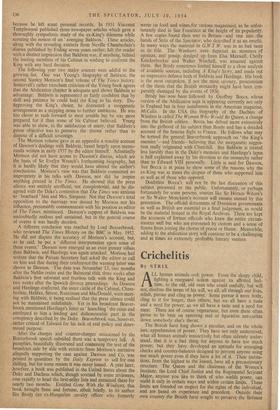The Abdication Story to Date
By GEORGE CURRY The author of this article is a British historian, now working cit the University of South Carolina, who has made a special study of the abdication of Edward VIII. This article is pub- lished as a factual antidote to the more romantic accounts of the question which have recently been appearing.
AFTER the dramatic and upsetting events of 1936 most loyal supporters of the British monarchy were content to forget a reign that was past history and to rally around a new sovereign. Although public interest in the secrets of the abdication remained high it was hardly encouraged. The most important official records were closed, the court servants traditionally silent and the revelations of elder states- men few. Moreover, throne and country were soon exposed to the trials of war. It was only in 1950, when King George VI and his Queen were firmly established, that the stream of revelations which to date shows no sign of abatement began in earnest.
As American journalism had contributed to the crisis by its determination to tell the worst, real or imaginary, about a king's infatuation, so it now gave an opportunity for the Duke of Windsor to present the facts as he saw them. In 1950 Life magazine printed his series of articles which was later expanded, with some of the harsher descriptions of Lang and Baldwin modified, into the volume A King's Story.' The Life series was illustrated with great taste and skill and provided the reader, as did the book, with a unique picture of the boy- hood of a prince, heir to the most stable and prosperous throne in the annals of European monarchy. Charles Murphy, a skilful American writer, now senior editor of Fortune, who is sometimes used by the White House to draft important policy memoranda, assisted the Duke with the text. A King's Story was a resounding success in the USA and in most of the countries of Europe. The British edition, published in 1951, likewise sold well. It was, however, generally felt in Great Britain, where critical interest was naturally higher than else- where, that the Abdication half of the book contained a great deal of controversial material.
The Duke made no secret of the fact that he had intended to be King on his own terms and that even before his reign began he was preoccupied with the problem of Mrs. Simpson. He also made a series of allegations, implied or actual, of a conspiracy against him in which the Prime Minister and Arch- bishop Lang were leading figures. Assisted by Dawson of The Times, Chamberlain, and others, this elderly pair pre- vented a reasonable presentation of his case to the country. blocked the compromise of a morganatic marriage which he had regarded as a generous concession to their objections, and virtually drove him from the throne. Another who suffered in the ex-King's narrative was Alec Hardinge, his Private Secre- tary, who had served King George V for sixteen years and whose warning letter to Edward was printed, in part, in the book. But there are also heroes in these memoirs. Beaver- brook and Churchill were kindly treated and Walter Monckton, brought in as substitute for Hardinge, was represented as totally partisan to the King's cause. Mrs. Simpson's role was not clearly portrayed, for it was never made clear if she had seriously considered the possibility of becoming Queen or planned for this exacting role, though she was apparently surprised to learn the meaning of the term ' morganatic.' A King's Story tended to leave many questions unanswered. However, it was a valuable' guide to Edward's attitude to his inheritance and its publication opened the way to rejoinders from some of those quarters which could not agree with the conspiracy ' theory.
Lockhart's biography of Lang, published in England while the Life articles were being written in the USA, showed the Archbishop in a different light. All might not agree with the sentiments which the Archbishop thought fit to express in his post-Abdication sermon, but during the course of the actual crisis he was shown to have stood aside, leaving Baldwin to act, though he made his sympathies plain in private acts. In this his attitude approximated to that of Queen Mary, whom Lang revered. It was hardly to be expected that the Primate of All England would favour Edward's conduct or hopes.. But if he plotted against his sovereign his diary effectively con- cealed the fact.
A defence of Baldwin was perhaps more difficult, largely because he left scant personal records. In 1951 Viscount Templewood published three newspaper articles which gave a thoroughly sympathetic study of the ex-King's dilemma while scouting the notion of an avenging Baldwin.' These articles, along with the revealing extracts from Neville Chamberlain's diaries published by Felling seven years earlier, left the reader with a distinct impression that Baldwin was, if anything, behind the leading members of his Cabinet in wishing to confront the King with any hard decision. The following year two major sources were addled to the growing list. One was Young's biography of Baldwin, the second Stanley Morison's final volume of' The Times history. Somervell's rather trenchant criticism of the Young book agrees that the Abdication chapter is adequate and shows Baldwin to advantage. Baldwin is represented as fairly confident that by skill and patience he could hold the King to his duty. Dis- dpproving the King's choice, he distrusted a morganatic arrangement as a stepping stone to further ambitions. He was too clever to rush forward to meet trouble but he was more prepared for it than some of his Cabinet believed. Young was able to show, to the satisfaction of many, that Baldwin's prime objective was to preserve the throne rather than to dispose of a difficult sovereign. The Morison volume gave in an appendix a notable account of Dawson's dealings with Baldwin, based largely upon memo- randa written in early 1937 by the editor himself. Admittedly Morison did not have access to Dawson's diaries, which are the basis of Sir Evelyn Wrench's forthcoming biography, but it is hardly likely that they would have altered the author's conclusions. Morison's view was that Baldwin committed no impropriety in his talks with Dawson, nor did he inspire anything printed in The Times. He showed that the press silence was entirely unofficial, not conspiratorial, and he dis- agreed with the Duke's contention that The Times was anxious to bombard' him and Mrs. Simpson. Not that Dawson's total opposition to the marriage was denied by Morison nor his influence, presumably commensurate with his position as editor of The Times, minimised. Dawson's support of Baldwin was undoubtedly zealous and sustained, but in the general course of events it was hardly decisive.
A different conclusion was reached by Lord Beaverbrook, who reviewed The Times History on the BBC in May, 1952. He did not dispute the accuracy of Morison's account, but, as he said, he put a different interpretation upon some of these events.' Dawson now emerged as an even greater villain than Baldwin, and Hardinge was again attacked. Morison had written that the Private Secretary had asked the editor to call on him and that during their conference the warning letter was shown to Dawson. The date was November 13, two months after the Nahlin cruise and the Balmoral visit, three weeks after Baldwin's first informal and fruitless talk with the King and two weeks after the Ipswich divorce proceedings. As Dawson and Hardinge conferred, the inner circle of the Cabinet, Cham- berlain, Halifax, Simon, Runciman and MacDonald, were meet- ing with Baldwin, it being realised that the press silence could not be maintained indefinitely. Yet in his broadcast Beaver- brook mentioned Hardinge's letter as ' launching' the crisis and attributed to him a leading and dishonourable part in the conspiracy described by the Duke. Beaverbrook was, however, rather critical of Edward for his lack of real policy and deter- mined purpose.
After the charges and counter-charges occasioned by the Beaverbrook speech subsided there was a temporary lull. A pamphlet, beautifully illustrated and containing the text of the broadcast side by side with extracts from Morison's narrative allegedly supporting the case against Dawson and Co. was printed in quantities by the Daily Express to sell for one shilling, but for some reason it was never Issued. A year later, howdver, a book was published in the United States about the ' Duke and Duchess which, though scorned by some reviewers, rose rapidly to head the best-seller lists and remained there for nearly two months. Entitled Gone With the Windsors, this hook brought fame and fortune, albeit briefly, to its author Iles Brody (an ex-Hungarian cavalry officer who formerly wrote on food and wines for various magazines); as he unfor- tunately died in San Francisco at the height of its popularity. A few copies found their way to Britain—and one into , the hands of Strix of the Spectator, who described it as an emetic. In many ways the material in G.W.7'.W. was in as bad taste as its title. The Windsors were depicted as monsters of egotism, and gossip, dredged up from Elsa Maxwell, Cholly Knickerbocker and Walter Winchell, was amassed against them. But Brody sometimes limited himself to a close analysis of available sources, including A King's Story, and made out an impressive defence both of Baldwin and Hardinge. His book is the most outspoken, if not the most savoury, presentation of the thesis that the British monarchy might have been irre- parably damaged by the events of 1936.
Brody has now been followed by Geoffrey Bocca, whose version of the Abdication 'saga is appearing currently not only in England but in four instalments in the American magazine, McCalls. In the USA this biography of the Duchess of Windsor is called The Woman Who Would Be Queen, a change from the British edition. Bocca has delved more extensively into the girlhood of his subject than Brody and has a detailed account of the famous flight to France. He follows what may be termed the general Beaverbrook approach on ' the King's enemies '—and friends—believing that the morganatic sugges- tion really originated with Churchill. But Baldwin is treated less harshly than in the Duke's memoirs and Hardinge's lapse is half explained away by his devotion to the monarchy rather than to Edward VIII personally. Little is said for Dawson, but Bocca is at pains to show some of the reasons why the ex-King was at times the despair of those who supported him as well as of those who opposed.
Doubtless Bocca's will not be the last discussion of this subject presented to the public. Unfortunately, or perhaps fortunately for some persons, sources like Sir Horace Wilson's or Sir Walter Monckton's account will remain unread by this generation. The official documents of Dominion governments as well as British are essential to a final judgement, as would be the material housed in the Royal Archives. There are kept the accounts of former officials who knew the entire circum- stances well but who are prevented by custom and a sense of fitness from joining the chorus of praise or blame. Meanwhile, adding to the abdication story will continue to be a challenging and at times an extremely profitdble literary venture.



































 Previous page
Previous page